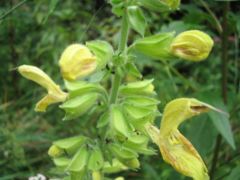Salvia glutinosa
| Salvia glutinosa subsp. var. | Jupiter's distaff | |||||||||||||||||||||||||||||||||||||||||||||||||||||||
|---|---|---|---|---|---|---|---|---|---|---|---|---|---|---|---|---|---|---|---|---|---|---|---|---|---|---|---|---|---|---|---|---|---|---|---|---|---|---|---|---|---|---|---|---|---|---|---|---|---|---|---|---|---|---|---|---|

|
|
| ||||||||||||||||||||||||||||||||||||||||||||||||||||||
| ||||||||||||||||||||||||||||||||||||||||||||||||||||||||
Salvia glutinosa is native to Central and East Europe, and West Asia. It is a deciduous perennial, up to about 1 meter in height, with yellow or yellow brown flowers. Its common names are Glutinous Sage, Sticky Sage, Jupiter's Sage, and Jupiter's distaff.
| Standard Cyclopedia of Horticulture |
|---|
|
Salvia glutinosa, Linn. (S. nubicola, Wall.). Perennial, about 3 ft. high: st. herbaceous, erect, glutinous-pilose, divaricately branched: lvs. petiolate, the lowest 7-8 in. long, the upper smaller, ovate-oblong, acuminate, dentate, the base cordate-sagittate; floral lvs. ovate, acuminate: racemes simple; floral whorls distant, laxly few-fld.; calyx tubular; corolla pale yellow, often 1 1/2 in. long, the tube exserted with its throat broadened. July. Eu. and Asia.
|
Cultivation
Propagation
Pests and diseases
Varieties
Gallery
-
photo 1
-
photo 2
-
photo 3
References
External links
- w:Salvia glutinosa. Some of the material on this page may be from Wikipedia, under the Creative Commons license.
- Salvia glutinosa QR Code (Size 50, 100, 200, 500)


